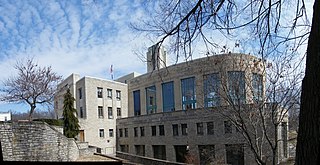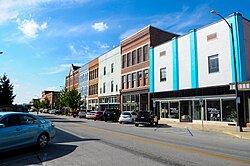
Brownfield is land that is abandoned or underutilized due to pollution from industrial use. The specific definition of brownfield land varies and is decided by policy makers and/or land developers within different countries. The main difference in definitions of whether a piece of land is considered a brownfield or not depends on the presence or absence of pollution. Overall, brownfield land is a site previously developed for industrial or commercial purposes and thus requires further development before reuse.

Mauricetown is a census-designated place and unincorporated community that is part of Commercial Township in Cumberland County, in the U.S. state of New Jersey.

Vincentown is an unincorporated community and census-designated place (CDP) located on the South Branch Rancocas Creek in Southampton Township of Burlington County, New Jersey. The area is served as United States Postal Service ZIP Code 08088.
The Walnut Street Historic District is a national historic district located in Springfield, Missouri, United States. The district encompasses more than 150 one and two story frame, brick, cast-stone, or stone dwellings in a thirteen block area. The district includes parts of East Walnut Street, East Elm Street, East McDaniel Street, Cordova Court, South Hampton Avenue, South Florence Avenue, and South National Avenue. The district developed between about 1870 and 1940, with 21 buildings surviving from before 1900, and 59 buildings dating between 1901 and 1910.

There are nine historic districts in Meridian, Mississippi. Each of these districts is listed on the National Register of Historic Places. One district, Meridian Downtown Historic District, is a combination of two older districts, Meridian Urban Center Historic District and Union Station Historic District. Many architectural styles are present in the districts, most from the late 19th century and early 20th century, including Queen Anne, Colonial Revival, Italianate, Art Deco, Late Victorian, and Bungalow.

Frank L. Packard was a prominent architect in Ohio. Many of his works were under the firm Yost & Packard, a company co-owned by Joseph W. Yost.

Barnett, Haynes & Barnett was a prominent architectural firm based in St. Louis, Missouri. Their credits include many familiar St. Louis landmarks, especially a number related to the local Catholic church. Their best-known building is probably the Cathedral Basilica of St. Louis. A number of the firm's works are listed on the U.S. National Register of Historic Places.

The Downtown Athens Historic District is a historic area in the Downtown Athens neighborhood of Athens, Georgia. It was listed on the National Register of Historic Places in 1978. Its boundaries were revised twice, in 1984 and 2006, and additional documentation was filed in 2006.

Edmond J. Eckel was an architect in practice in St. Joseph, Missouri, from 1872 until his death in 1934. In 1880 he was the founder of Eckel & Mann, later Eckel & Aldrich and Brunner & Brunner, which was the oldest architectural firm in Missouri prior to its eventual dissolution in 1999.

Excelsior Springs Hall of Waters Commercial East Historic District is a national historic district located at Excelsior Springs, Clay County, Missouri. It encompasses 24 contributing buildings and 2 contributing structures in the central business district of Excelsior Springs. The district developed between about 1894 and 1948 and includes representative examples of Victorian architecture. The central feature of the district, the separately listed Hall of Waters, is a five level, Art Deco / Depression Modern style reinforced concrete building. Other notable buildings include the Flanders Dry Goods Store, A.M. Howard Drug Store (1905-1909), Clay County State Bank (1906), The Huey Building (1908), Oriental Bazaar Gift Store (1908), The Excelsior Baths and Broadway Rooms, Fraternal Order of Eagles Lodge Hall, The Kennedy Building (1902), First National Bank Building, The Francis Hotel, and The Auditorium.
Walnut Street Commercial Historic District is a national historic district located at Springfield, Greene County, Missouri. The district encompasses seven contributing buildings in a commercial section of Springfield. The district developed between about 1895 and 1949, and includes representative examples of Italianate and Colonial Revival style architecture. Located in the district is the separately listed Landers Theater. Other notable buildings include the Masonic Temple (1906).
West Walnut Street Commercial Historic District is a national historic district located in Springfield, Missouri, United States. The district encompasses 14 contributing buildings in a commercial section of Springfield. The district developed between about 1888 and 1951, and includes representative examples of Italianate commercial architecture. Notable buildings include the Diffenderffer Building (1906), the Koenigsbruk and Boehmer Building, and the Grand Hotel / Springfield Seed Co. Building.
South Avenue Commercial Historic District is a national historic district located in Springfield, Missouri, United States. The district encompasses 10 contributing buildings in a commercial section of Springfield. The district developed between about 1895 and 1949, and it includes representative examples of Italianate and Colonial Revival style architecture. Notable buildings include the Medical Arts Building (1929) and Springfield Life Building/Savoy Hotel/Hotel Seville.
Campbell Avenue Historic District is a national historic district located in Springfield, Missouri, United States. The district encompasses 11 contributing buildings in a commercial section of Springfield. The district developed between about 1885 and 1948, and it includes representative examples of Italianate and Colonial Revival style architecture. Notable buildings include the McLaughlin Block and Busy Bee Department Store.
Springfield Warehouse and Industrial Historic District is a national historic district located in Springfield, Missouri, United States. It encompasses 16 contributing buildings and 1 contributing structure in a commercial / industrial section of Springfield. Developed between about 1891 and 1948, the district also includes representative examples of Italianate and Romanesque Revival style architecture. Notable buildings include the Springfield Ice and Refrigerator Company, Armour Creamery Boiler House, Andrew Rebori Company, Crighton Provision Company, and Armour Creamery Cold Storage Warehouse.

Springfield Public Square Historic District is a national historic district located at Springfield, Missouri, United States. The district encompasses 27 contributing buildings, 1 contributing site, 1 contributing structure, and 2 contributing objects in Springfield's central business district. The district developed between about 1890 and 1959, and includes representative examples of commercial architecture. Located in the district are the separately listed Franklin Springfield Motor Co. Building, Gillioz Theatre, Heer's Department Store, Netter-Ullman Building, and Marx-Hurlburt Building. Other notable resources include the Landers Building (1915), F. W. Woolworth Co. (1954), J. J. Newberry Co. (1951), S. S. Kresge Co. (1953), Springfield Cigar Company, Stancill Drug Store, National Shirt Co, Salvation Army, Public Square, Queen City Bank (1914), Frisco Office Building (1910), and Cantrell Building.

The Sedalia Commercial Historic District is a national historic district located at Sedalia, Pettis County, Missouri. It encompasses 102 contributing buildings in the central business district of Sedalia. The district developed between about 1870 and 1959, and includes representative examples of Italianate, Romanesque Revival, and Art Deco architecture. Located in the district are the separately listed Hotel Bothwell, Building at 217 West Main Street, and Missouri/Sedalia Trust Company. Other notable buildings include the First United Methodist Church (1888-1891), Pettis County Courthouse (1924), Anheuser Busch Bottling Works, the New Lona Theater (1920), Citizens National Bank Building, Third National Bank (1929), Federal Building (1930), Montgomery Ward Building (1936), the Uptown Theatre (1936), Missouri Pacific Depot, and Central Presbyterian Church.

The Asbury Historic District is a 288-acre (117 ha) historic district encompassing the community of Asbury in Franklin Township of Warren County, New Jersey. It is bounded by County Route 632, County Route 643, Maple Avenue, Kitchen Road, and School Street and extends along the Musconetcong River into Bethlehem Township of Hunterdon County. It was listed on the National Register of Historic Places on March 19, 1993 for its significance in architecture, industry, religion, community development, politics/government, and commerce. The district includes 141 contributing buildings, a contributing structure, two contributing sites, and four contributing objects.

Julian Franklin Everett was an American architect known for the buildings he designed in Seattle, Washington. His work includes a synagogue for the Temple de Hirsch congregation (1908) and the Pioneer Square Comfort Station and Pergola in Seattle (1909), now a historic landmark. Some of his works, including the temple and a building for Pathé Exchange, were later demolished, while others are listed on the National Register of Historic Places (NRHP).

The Deer Lodge Central Business Historic District, in Deer Lodge, Montana, in Powell County, Montana, is a historic district which was listed on the National Register of Historic Places in 2008.



















